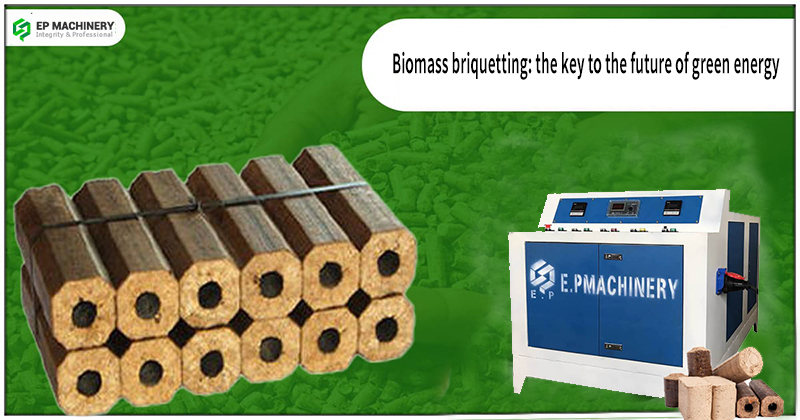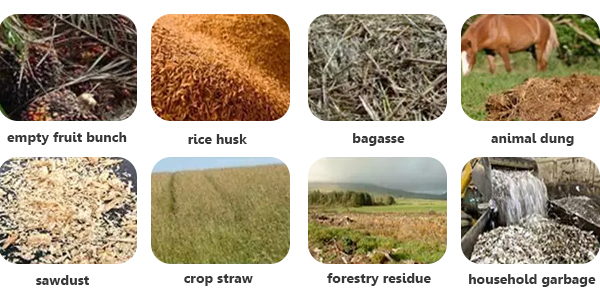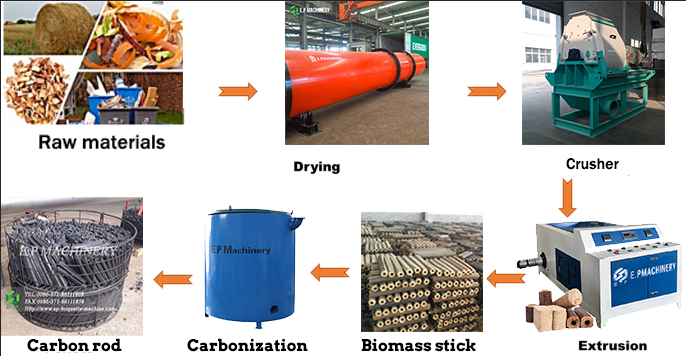Biomass briquetting: the key to the future of green energy
- 2024-05-15 09:45:00
- E.P Original
- 1978

1. The importance of biomass briquetting factory
2. What is biomass energy? What are biomass materials?
3. Preparation for factory construction: What are the key factors in choosing a suitable location?
4. How to evaluate resources and market potential
5. Technical process: from raw materials to finished products
6. Main equipment and technical support required to produce biomass briquettes
7. The impact that the production of biomass briquettes may have on the ecological environment, and how to achieve sustainable development through factory operations.
8. The government’s support policies for the biomass energy industry and the demand and potential of biomass briquette products in the current and future markets.
9. Budget for setting up a biomass briquetting plant
10. The future of biomass briquetting plants
The importance of biomass briquetting plants
As a renewable energy source, biomass briquettes are increasingly important in today's society. Made from agricultural waste, wood residues and other organic matter compressed under high pressure, they not only provide the world with clean, renewable energy options, but also effectively mitigate the environmental damage caused by fossil fuels. As the global pursuit of sustainable development deepens, biomass briquettes are increasingly used to help reduce greenhouse gas emissions and improve air quality, while also promoting economic development and employment opportunities in rural areas. Therefore, establishing a biomass briquetting plant has both environmental and economic significance. By efficiently utilizing this green energy, we can contribute to the future of our planet while ensuring the sustainability of our energy supply and leaving a more livable environment for future generations.
What is biomass energy? What are biomass materials?
Biomass energy is a renewable energy converted from biological materials, which comes from a wide range of sources, including plants, animals and microorganisms. These organisms convert solar energy into chemical energy through photosynthesis or chemical reactions and store it in their bodies to form biomass.
There are many types of biomass energy. According to their sources and properties, they can be divided into various types such as lignocellulosic biomass, agricultural waste, livestock and poultry manure, and aquatic biomass. Among them, lignocellulosic biomass mainly includes wood, bamboo, paper, etc., which contain high cellulose and lignin and are an important component of biomass energy. Agricultural wastes such as straw, corn cobs, rice husks, etc. are widely used in the production of biomass energy due to their large yield and easy acquisition. Livestock and poultry manure is a biomass resource rich in organic matter, which can be converted into energy such as biogas through anaerobic fermentation. Aquatic biomass, such as seaweed, algae, etc., is considered to be a potential biomass energy due to its fast growth rate and high oil content.
In general, biomass energy is a clean and renewable energy source with various types and characteristics, providing a wealth of choices for our energy structure.

Preparation for factory construction: What are the key factors in choosing a suitable location?
In the preliminary preparations for factory construction, choosing an appropriate location is crucial, as it is directly related to the production efficiency and operating costs of the factory. The supply of raw materials is the primary consideration. If it is difficult to obtain raw materials or the transportation distance is too long, production costs will be greatly increased. Therefore, choosing a location close to the origin of raw materials will greatly facilitate production. At the same time, transportation conditions are also an important consideration. Convenient transportation can ensure that products are delivered to the market in time, reduce storage pressure, and improve corporate competitiveness. In addition, the judgment of market demand is also essential. Only by deeply understanding the demand of the target market can we ensure stable sales of our products.
How to assess resources and market potential
After considering the above key factors, it is also necessary to conduct an assessment of resources and market potential. This includes not only the analysis of the adequacy and sustainability of current resources, but also the prediction and judgment of future market demand. Through a comprehensive evaluation of these factors, it can be determined whether the selected location has the advantages of building a factory, thereby providing a solid foundation for subsequent construction work.
Technical process: from raw materials to finished products
In the production process of biomass briquettes, we first need to collect raw materials. The selection of raw materials directly affects the quality of the finished product, so biomass raw materials with good quality and appropriate moisture content must be selected. Then, we preprocess the collected raw materials, including crushing, screening and other steps, aiming to make the raw materials reach a suitable state for compression. Next is the key compression and briquetting link. A professional briquetting machine is used to compress the processed raw materials into briquettes. This step requires high-precision equipment and skilled operators to ensure the density and shape specifications of the briquettes. The compressed biomass blocks then go through a drying process to reduce moisture and improve combustion efficiency. The last step is to package the briquettes for easy transportation and storage. We usually use moisture-proof and pressure-resistant packaging materials to ensure stable product quality during transportation and storage. Through this series of delicate production processes, biomass briquettes can be transformed from initial raw materials into usable and efficient clean energy products.

In the process of producing biomass briquettes, key equipment and technology selection and investment are crucial. First of all, the main equipment usually includes biomass raw material processing equipment, molding equipment, and post-processing equipment. The selection of these equipment needs to take into account factors such as the scale of production, types of raw materials, and product requirements. Secondly, technical support mainly includes equipment operation technology, maintenance technology and quality control technology. The mastery and application of these technologies are directly related to production efficiency and product quality.
Main equipment and technical support required to produce biomass briquettes
For investors, cost-benefit analysis of different technical routes is essential. Generally speaking, although the initial investment of advanced equipment and technology is high, it has high operating efficiency, good product quality, and has higher economic benefits in the long run. Although the initial investment of traditional equipment and technology is low, it may lead to high long-term operating costs and unclear economic benefits due to factors such as low efficiency and poor product quality. Therefore, when making decisions, investors need to comprehensively consider factors such as the performance and price of equipment and technology, as well as their own economic strength and market prospects.
The impact that the production of biomass briquettes may have on the ecological environment, and how to achieve sustainable development through factory operations.
When considering the production of biomass briquettes, we inevitably need to face its possible impact on the ecological environment. In the production of biomass briquettes, every step from the collection and processing of raw materials to the output of finished products may have a certain impact on the environment. For example, excessive collection of raw materials may destroy the ecological balance, and the waste that may be generated during processing may also cause environmental pollution. However, we should also see that as a renewable energy source, biomass briquettes have a much lower negative impact on the environment than traditional fossil energy sources. Therefore, we need to reduce environmental damage as much as possible during the production process and achieve a win-win situation between production and environmental protection.
In terms of factory operations, we can improve production efficiency and reduce waste generation by introducing advanced production equipment and technology. At the same time, we can also rationally allocate resources through scientific management to avoid excessive collection of raw materials and protect the ecological environment. In addition, we can also achieve the goal of sustainable development by establishing a complete environmental protection system, effectively processing and recycling waste generated during the production process, and realizing the resource utilization of waste. In general, only by integrating environmental protection into all aspects of production can we truly achieve sustainable development of biomass briquette production.
The government's support policies for the biomass energy industry and the demand and potential of biomass briquette products in the current and future markets.
In modern society, the concepts of environmental protection and sustainable development are deeply rooted in the hearts of the people, and the biomass energy industry has therefore received strong support from the government. Governments at all levels have vigorously promoted the research and development and production of biomass briquette products through a series of supporting policies, such as tax incentives, financial subsidies and technology research and development support. These policies not only reduce the operating costs of enterprises, but also stimulate more enterprises to invest in this industry. At the same time, with the improvement of people's environmental awareness and the urgent demand for renewable resources, the market demand for biomass briquette products is growing day by day. In the future, the biomass energy industry will have broad market potential, and government support policies will further promote its development and make it a shining star in the new energy field.
Budget for setting up a biomass briquetting plant
Financial planning for establishing a biomass briquetting plant is a comprehensive and systematic process that covers the need for start-up capital, cost calculations, and revenue forecasts. In terms of start-up capital requirements, we need to consider factors such as the location, size, equipment purchase, and raw material procurement of the factory. These are key factors in determining the amount of initial investment. In terms of cost calculation, we need to include fixed costs such as equipment depreciation, site rental, etc., as well as variable costs such as raw material consumption, labor input, etc. The estimation of these costs will directly affect our pricing strategy and profit margins. Finally, for revenue forecasting, we need to estimate product sales volume and sales price based on market research, and then predict future revenue. Through an in-depth analysis of these financial data, we will be able to provide a clear budget framework for setting up a biomass briquetting plant.
The future of biomass briquetting plants
After discussing the many advantages of the biomass briquetting plant, it is not difficult to summarize its huge contribution to environmental protection and energy sustainability. As a green industry, it not only relieves the pressure of traditional fossil energy on the environment, but also provides new ways to utilize agricultural waste and realizes resource recycling. Looking to the future, biomass briquetting plants will continue to receive attention for their dual environmental and economic values. With the continuous development and innovation of technology, the improvement of production efficiency and the reduction of costs will be an inevitable trend. At the same time, with the growing global demand for clean energy, the scale and market of biomass briquetting plants will also usher in broader development space. In addition, the support and guidance of national policies will further promote its industrialization process, making it an important force in future energy structure adjustment and ecological civilization construction. In short, the future of the biomass briquetting plant is broad and worthy of our joint expectations and efforts.
Phone
+86-13673361755
+86-13673361755
Telephone
+86-371-8611808
sale@ep-machine.com
Address
Shenglongjinzhonghuan Building, Zhongyuan District Zhengzhou City, Henan Province, China.
